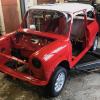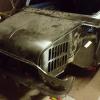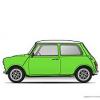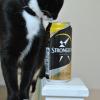I am a bit concerned that the OP does not quite understand how an engine is built/re-built and what measurements are needed and how to do those measurements. There seems to be some potential for a set of expensive errors here and I think we need to explain very clearly what needs to be done.
First of all, the crankshaft has both main bearing journals and big-end bearing journals. The crankshaft can be accurately machined to give smaller diameter journals, bot main and big-ends, to correct wear and scoring in the journals. Thus the journals become undersize and there are standard under-sizes for which the correct bearing shells are available. With a Mini engine these are normally -0.010" (ten thou), -0.020" (20 thou), -0.030" and 0.040". The backs of the replacement shells are marked with this undersize and the undersize is a specific part number. The crankshaft needs to be inspected to see if the journals are unmarked and if they are within manufacturer's tolerance for the size which they are at. For this a micrometer screw gauge is vital (not a digital vernier as that is not accurate enough). Also check that the journals are truly circular by measuring at several places around the circumference. Only then can the big-end and main bearing shells be order from a good supplier. The running clearance of the bearings to journals needs to be 0.001" to 0.0025", but if the crankshaft is within tolerance for the size to which it is ground and the correct bearing shells are fitted this tolerance will be achieved. 'Plastigauge' can be used to verify the clearance, although this is mostly only done on high performance or competition engines.
Moving on to the crankshaft end-float. When installed with the correct bearing shells and a set of standard thrust bearings (sometimes called 'thrust washers) the end-to-end movement of the crankshaft, known as the longitudinal float) can be measured using a Dial Test Indicator (DTI) with a magnetic base. Ste the DTI pointer onto a crankshaft web with the DTI pointer shaft in the horizontal position and aligned with the crankshaft. Using a thin screwdriver gently prise the crankshaft as far as it will go one way and zero the scale on the DTI. Then gently prise it as fr as it will go the other way and read the movement of the DTI. The required final float is between 0.002" and 0.005". If it is more than 0.005" and up to 0.008" you can use a single pair of 0.003" oversize thrust washers to bring it down to a float within the correct figures. If it is over 0.008" and under 0.011" you use two pairs of +0.003" over size to bring it down by 0.006" to an acceptable level. If the float is over 0.011" you require one set of 0.003" oversize and a single pair of 0.030" thrusts which have to be machined down to give the correct float of 0.002" to 0.005" after final assembly. This needs the proper machining equipment and some very accurate measuring and machining.
Use plenty of engine assembly lube during all stages of assembly. Make sure the torque settings are done correctly with an accurate torque wrench.
I hope this is clear, but if it is not, then think carefully about continuing with the build until it is fully understood how this works in practice and what needs to be achieved. It must be done EXACTLY right, which is why professional engine builders are not cheap with their labour costs. Each engine is assembled at least twice, sometimes more, with one or two 'trial builds' along the way.
We are all here to help, but in the end you MUST understand fully what you are doing.



















